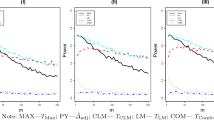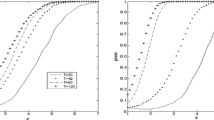Abstract
The linear regression models are widely used in different research fields, and often there is the need to analyze if there are similarities between two or more different linear models or to verify if a given relation between two variables remains the same in different intervals of time, in particular in cases where small differences might make a big difference. Motivated by these problems the authors consider a test of equality of k linear regression models which is a simultaneous test of equality of slopes, intercepts and variances. In order to overcome the extreme difficulties that exist in the use of the exact distribution of the likelihood ratio test (LRT) statistic and to make this test reliable and easy to use, we propose the use of near-exact distributions to approximate the distribution of the LRT statistic, under \(H_0\), in the balanced case, and of new asymptotic approximations for the unbalanced case. The near-exact approximations are built by approximating one factor of an adequate factorization of the characteristic function of the logarithm of the LRT statistic and may be easily implemented. The asymptotic approximations are developed using an expansion for the ratio of gamma functions. The quality of these approximations is analyzed and confirmed. Power studies are conducted in order to better assess the performance of the test. Finally to illustrate the applicability of the test we consider a real data set of gross domestic product at market prices and final consumption expenditure in European countries and one tests the existence of similarities between countries.







Similar content being viewed by others
References
Azaisa J-M, Delmas C, Rabier C-E (2014) Likelihood ratio test process for quantitative trait locus detection. Statistics 48:787–801
Box GEP (1949) A general distribution theory for a class of likelihood criteria. Biometrika 36:317–346
Bretz F, Hothorn T, Westfall P (2008) Multiple comparison procedures in linear models. In: Brito P (ed) COMPSTAT 2008. Proceedings in computational statistics. Physica-Verlag, Heidelberg
Chen HJ, Yuan SP (1982) On concurrence of several linear regressions and applications to problems of enzyme kinetics. Statistics 11:395–409
Coelho CA (1998) The generalized integer Gamma distribution—a basis for distributions in multivariate statistics. J Multivar Anal 64:86–102
Coelho CA (2004) The generalized near-integer gamma distribution: a basis for ‘near-exact’ approximations to the distribution of statistics which are the product of an odd number of independent beta random variables. J Multivar Anal 89:191–218
Coelho CA, Marques FJ (2009) The advantage of decomposing elaborate hypotheses on covariance matrices into conditionally independent hypotheses in building near-exact distributions for the test statistics. Linear Algebra Appl 430:2592–2606
Coelho CA, Marques FJ (2010) Near-exact distributions for the independence and sphericity likelihood ratio test statistics. J Multivar Anal 101:583–593
Coelho CA, Arnold BC, Marques FJ (2010) Near-exact distributions for certain likelihood ratio test statistics. J Stat Theory Pract 4:711–725
Coelho CA, Alberto RP (2012) On the distribution of the product of independent beta random variables applications. Technical report, CMA 12
Deaton A (1992) Understanding consumption. Oxford University Press, Oxford
Johansen S (2000) A Bartlett correction factor for tests on the cointegrating relations. Econom Theory 16:740–778
Krugman PR, Obstfeld M, Melitz MJ (2012) International economics: theory and policy. Pearson, Harlow
Luke YL (1969) The special functions and their approximations. Academic Press Inc, London
Marques FJ, Coelho CA (2013) Obtaining the exact and near-exact distributions of the likelihood ratio statistic to test circular symmetry through the use of characteristic functions. Comput Stat 28:2091–2115
Marques FJ, Coelho CA, Arnold BC (2010) A general near-exact distribution theory for the most common likelihood ratio test statistics used in multivariate analysis. Test 20:180–203
Moschopoulos PG (1986) New representations for the distribution function of a class of likelihood ratio criteria. J Stat Res 20(1&2):13–20
Moschopoulos PG (1989) Tests of hypotheses on concomitant variables in linear models. Commun Stat Theory Methods 18(5):1735–1746
Nielsen HB, Rahbek A (2007) The likelihood ratio test for cointegration ranks in the I(2) model. Econom Theory 23:615–637
Nkurunziza S (2008) Likelihood ratio test for a special predator–prey system. Statistics 42:149–166
Park J, Sinha B, Shah A, Xu D, Lin J (2015) Likelihood ratio tests for interval hypotheses with applications. Commun Stat 44(11):2351–2370
Paternoster R, Brame R, Mazerolle P, Piquero A (1998) Using the correct statistical test for the equality of regression coefficients. Criminology 36:859–866
Solomon H, Stephens MA (1978) Approximations to density functions using Pearson curves. J Am Stat Assoc 73:153–160
Stöckl D, Dewitte K, Thienpont LM (1998) Validity of linear regression in method comparison studies: is it limited by the statistical model or the quality of the analytical input data? Clin Chem 44:2340–2346
Tricomi FG, Erdélyi A (1951) The asymptotic expansion of a ratio of gamma functions. Pac J Math 1:133–142
Wilks SS (1938) The large-sample distribution of the likelihood ratio for testing composite hypotheses. Ann Math Stat 9:60–62
Acknowledgements
This work was partially supported by the Fundação para a Ciência e a Tecnologia (Portuguese Foundation for Science and Technology) through the Project UID/MAT/00297/2013 (Centro de Matemática e Aplicações).
Author information
Authors and Affiliations
Corresponding author
Appendix: Empirical power values
Appendix: Empirical power values
1.1 Balanced case
See Tables 14, 15, 16, 17, 18 and 19.
1.2 Unbalanced case
See Tables 20, 21, 22, 23, 24 and 25.
Rights and permissions
About this article
Cite this article
Marques, F.J., Coelho, C.A. & Rodrigues, P.C. Testing the equality of several linear regression models. Comput Stat 32, 1453–1480 (2017). https://doi.org/10.1007/s00180-016-0703-1
Received:
Accepted:
Published:
Issue Date:
DOI: https://doi.org/10.1007/s00180-016-0703-1




